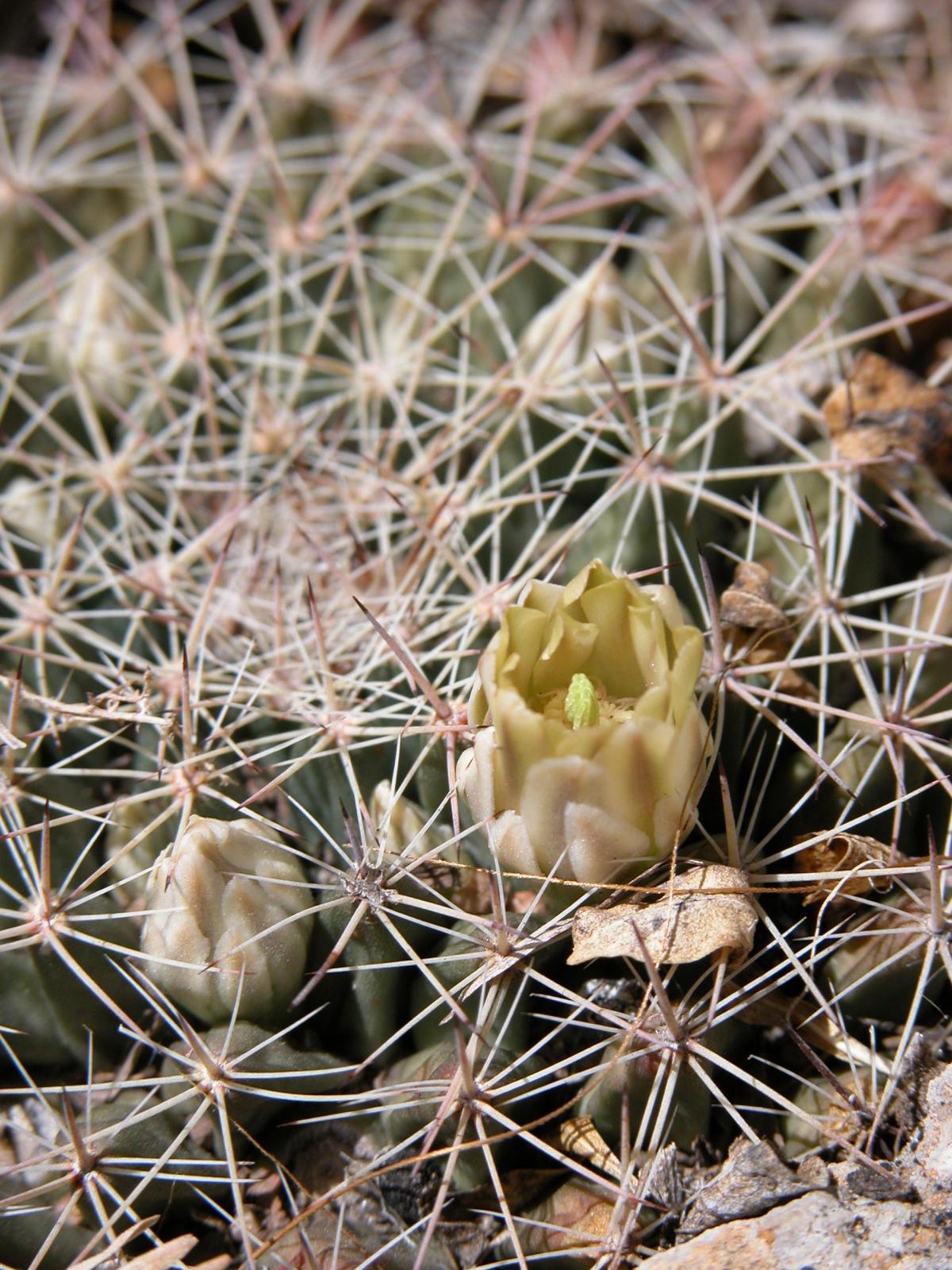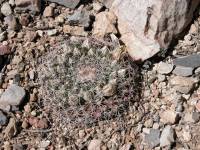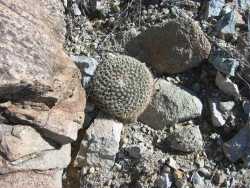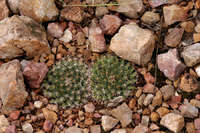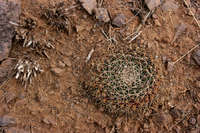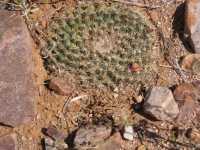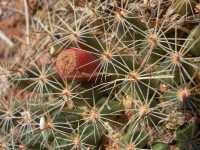Mammillaria heyderi
|
|
|
|
Family: Cactaceae
little nipple cactus, more...Pancake Nipple Cactus, Heyder pincushion cactus
[Mammillaria parrasensis Repp.] |
Plants unbranched, protruding relatively little above soil. Roots obconic taproots; secondary roots diffuse. Stems top-shaped, flat-topped (aerial part sometimes hemispheric in old age or in dense subtropical vegetation), protruding above ground 0-2 × (4-)7.5-15 cm, firm; tubercles 9-15(-20) × 3-7 mm; axils with short wool, bristles absent; cortex and pith not mucilaginous; latex abundant in healthy tissue throughout cortex of stem, tubercles, and sometimes flower receptacle, sticky, white. Spines (8-)10-18(-27) per areole, usually brownish, darker at tip, glabrous; radial spines (8-)10-22(-26) per areole, white to white-and-brown or brown , needlelike, 6-15(-16) mm, stiff, abaxial spines longest; central spines (0-)1(-4) per areole, porrect or ascending, not hooked, (0.5-)2-8 × 0.15-0.45 mm; subcentral spines 0. Flowers 1.9-3.8 × 1.5-3 cm; outermost tepal margins entire; inner tepals white, greenish or cream to pale pink, with tan, pink, greenish, or brownish midstripes, 11-19 × 2-2.5 mm; stigma lobes externally green, internally green or red (or pink), 2.5-3 mm. Fruits brilliant red: scarlet, carmine, or crimson, obovoid to clavate, 10-35(-40) × 5-8 mm, juicy only in fruit walls; floral remnant weakly persistent. Seeds reddish brown, sometimes yellowish when fresh, 1-1.2 mm, deeply pitted; testa thin, relatively flexible; anticlinal cell walls sinuate, interstices narrower than pit diameters; pits cavernous or deeply concave. 2n = 22. Green fruits of Mammillaria heyderi with fully mature, viable seeds precede the ripe (elongate) fruits by six months to a year.
Benson 1982, FNA 2003 Common Name: little nipple cactus Duration: Perennial Protected Status: No status in Arizona. General: Unbranched plants with stems barely above soil and flat topped to hemispheric above ground, 0-2 cm tall by 7.5-15 cm wide and firm with tubercles 9-15 mm long and 3-7 mm broad, the axils have short wool and no bristles, there is also an abundant latex that is sticky and white. Spines: Spines 10-18 and usually brownish while being darker at tip and glabrous, the 10-22 radial spines are white to white brown and needlelike, 6-15 mm and stiff with the lower spines the longest, with usually 1 central spine per areole which are ascending but not hooked, 2-8 mm long and less that half of 1 mm wide with no subcentral spines. Flowers: Small, usually only 2-4 cm tall and 1.5-3 cm wide, the outermost tepal margins entire while the inner tepals are white, greenish or cream to pale pink, with brownish midstripes, the stigma lobes are green outside and internally green or red while the flowers form a circle around the stem just below the apex. Fruits: Brilliant scarlet red and 10-35 mm by 5-8 mm, juicy in fruit walls. Ecology: Found in gravelly limestone soils from 4,000 -7,000 ft (1219-2134 m), flowers October-March. Distribution: s AZ, CO, NM, s TX, OK; south to n MEX. Notes: Distinguished as having stems that are 7.5-15 cm in diameter, and are hemispheric to flat-topped and barely rising above the ground; flowers from axils of tubercles and arising in a ring away from the apex; and radial spines mostly >12/areole (the similar macdougalii has 10-12). Considered rare in all counties in which it occurs in Arizona. FNA distinguishes those species which were formerly of M. gummifera to be included as var. bullingtoniana which includes most of the collections that were thought to be made in southeastern Arizona, which incidentally is distinguished as being one fourth larger than var. heyderi in all dimensions. However, the collections that have been identified in the region actually include what is now M. macdougalii and M. heyderi var. heyderi. Ethnobotany: Unknown Etymology: Mammillaria comes from the Latin mammilla, a nipple, while heyderi is named for Edward Heyder (1808-1884) a German cactus grower. Synonyms: None Editor: SBuckley 2010, FSCoburn 2015 |

